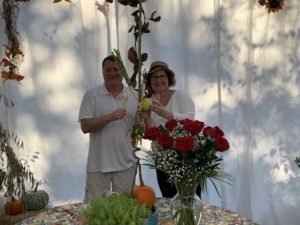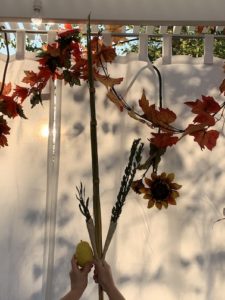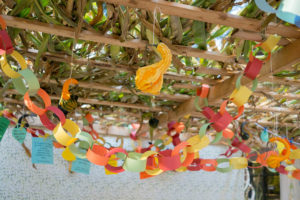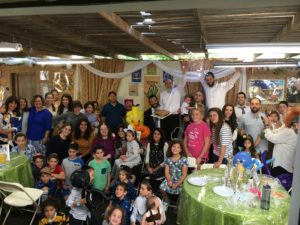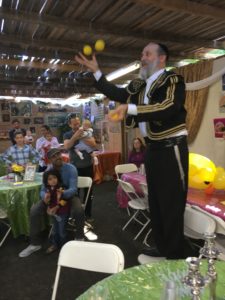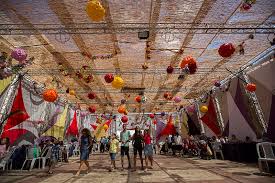Our Anniversary In The Sukkah
Twenty seven years ago, my husband and I stood under the huppa (chuppa) and made our vows to stick together through the best and worst of times and everything in between. We made a commitment to create a life together based on Jewish values under the watchful eye of God, that’s what a huppa is all about.
Today, on the last day of Sukkot, which is also Shabbat, known as Hoshana Rabbah, we are renewing our vows to each other and, by doing certain rituals under the sukkah, we are renewing our vows to God and the the Jewish people.
When I was a bride I clutched a bouquet of ivory roses as I walked down the aisle towards my soon-to-be husband who stood under the huppa waiting for me with a nervous smile on his face. Today, I hold in my hand the sweet smelling fruit called etrog (esrog) with the palm, myrtle and willow branches of the lulav, and wave the Four Species together in all directions in the sukkah. Scott’s still smiling, but this time because I’m shaking my lulav and we’re having strudel for dessert.
Lulav and Etrog Symbolize Unity
I have chosen Sukkot as the theme of this year’s anniversary–why not–considering the actual modern gift associated with the 27th year is “sculptures.” So, here’s my attempt to connect the meaning of the sanctity of marriage to this joyous holiday.
The lulav and etrog can be compared to a married couple, who bring their own unique qualities and strengths to a relationship. A lulav is a slender palm branch that is held together with two willow branches and three willow branches. An etrog, or citron, looks like an enlarged bumpy lemon and a whiff of the subtle scent is heavenly and intoxicating. Together, the branches and fruit have their own beauty and symbolism.
A midrash explains that the Four Species symbolize the importance of unity among different types of Jews. The etrog has both a flavor and a scent, like a Jew who is both learned and observant of the commandments. The lulav is from a date palm, and so it has a taste but no scent. It is likened to a Jew who is learned but does not apply that knowledge in action. A myrtle has a pleasant odor but no taste, and it represents the Jew who has little book learning behind his or her observance. Finally, the willow lacks both fragrance and taste, just like the Jew who neither studies the Torah nor keeps the commandments. These differences among Jews are substantial, yet we can still come together in solidarity, just as the lulav and etrog are bound together to merit a blessing. Same as a married couple. We bring our own unique qualities to the relationship, and we are better, stronger when we are committed as one.
Raise The Roof On The Symbolism of Sukkot
You shall dwell in huts (sukkot) for seven days. Every member of the Jewish people shall dwell in huts, so that your generations shall know that I had the Israelites dwell in huts when I took them out of Egypt.
Many years ago when I built my first sukkah in my own backyard, I was super excited to find a pile of freshly cut tree branches in the temple parking lot in carpool line.
It was fate. Or as we say in Hebrew, kismet. Since nobody else was claiming this tree limb treasure, I somehow managed to drag the logs like a lumberjack to my van and shove the messy branches into my newly vacuumed back seat. Little did I know these leafy sticks that I was about to lay on the roof of my sukkah had a name, s’chach  and I was doing a mitzvah. Continue reading
Sukkot Celebrates Fall Harvest…And Much More
Now that Yom Kippur is over and the hard work is done, it’s time to get ready for the next Jewish holiday, Sukkot (Hebrew word for booths or huts),  a week-long harvest festival that begins Sunday night, five days after Yom Kippur.
The festival of Sukkot is one of the three great pilgrimage festivals—the others are Passover (April 8-16) and Shavuot (May 28-30). These holidays celebrate both agricultural festivals and historical events in the history of the Jewish people, when in ancient times Jewish people traveled to the Temple in Jerusalem. In Israel, Sukkot is a major holiday, no work, no school, and everyone is outdoors sharing meals, singing songs, and giving thanks for the bounty of another season.
Also known as the Feast of Tabernacles, Sukkot is like the American holiday Thanksgiving in that we give thanks for another season of crops that will sustain us, but it is so much more. Sukkot ranks right up there in important holidays because it commemorates the time when we received the Torah at Mount Sinai, were freed from slavery, and wandered the desert for 40 years to the Promised Land. Jews today are still on a journey, and holidays like Sukkot remind us to free ourselves from the material things that often keep us in bondage. It’s a time to detach from the comforts we are accostomed to inside our houses and reconnect with the natural wonders that sustain us inside a flimsly little hut called a sukkah (singular word for Sukkot). Continue reading
It’s Simchat Torah! Let’s Dance!
Ya know how when you throw an epic party and everyone comes and has a great time, and there’s always one last person to leave? It’s like the ultimate Jewish goodbye. Well that’s my analogy for Simcha Torah, and the guest of honor is God, who wants us to soak in every last bit of happiness and newfound wisdom from the weeklong festival of Sukkot. When we welcome guests into our outdoor huts and we gather together in the beauty of nature and under the stars, we are humble and grateful.  We aren’t focused on material things that separates us, but rather the simple joys that bring us together. My mouth is still watering from dipping soft chewey challah into tahini stuffed eggplant and butternut squash soup, a few of the delicacies that wet our appetites for a feast served inside the sukkah of Rabbi Yosef and Mimi David. Consideirng the meal began after sundown, when the stars appeared, it was a late nite before we said our goodbyes. As we walked down the sidewalk together, we heard the sounds of crickets chirping and the faint singing of neighbors down the street who were still rejoicing after a full day of fun in their annual Yari sukkah party with lots of children, families, balloon making, moon bounce, a juggling rabbi, and a dairy meal of pasta, quiche, and sweets that kept on coming. This feeling of joy is what we strive for when Sukkot is finally over and we move back into our homes and return to our everyday lives. We try to maintain the closeness to each other, to God, and to nature.
Sukkot Celebrates Bountiful Harvest with Family, Friends, Food & Fun
The week-long festival of Sukkot, the Hebrew word for “booths,†begins when the sun goes down tomorrow night (September 23-30), and is considered one of the happiest times in the Jewish calendar. When else are we commanded to build a hut-like structure, called a sukkah, in our backyard, decorate it with fresh fruit, gourds and other Judaica ornaments, and get to eat our meals alfresco and even sleep under roofs of branches open to the stars? Continue reading
Sukkot: What We Learn When Our Walls Come Down
When Yom Kippur ends, another Jewish holiday begins. Sukkot! This week-long pilgrimage festival (October 5-13, 2017) commemorates the time when Israelites wandered the desert for 40 years after escaping from slavery in Egypt. The Jewish people built temporary tent-like structures to sleep, eat, and dwell in, and it’s a mitzvah for us to build a sukkah and to immerse ourselves in nature and God’s presence. At this time in our world, when everyday seems to bring another natural or manmade tragedy, from the hurricanes to mass shootings, we are reminded of how vulnerable we really are. The safety of four concrete walls can’t protect us from harm. Also, when we isolate ourselves in our shelters, we can’t connect with each other. So, Sukkot is a time for our walls to come down, for us to be in touch with not only nature and with God, but also with each other. During Sukkot, we are reminded that God’s presence is bigger than all of us. Sukkot, yet another opportunity to make the ordinary–like an outdoor hut–holy again. Continue reading
Mom Tries Camping Again, Only In A Sukkah
Yom Kippur starts out as the most solemn holiday of the Jewish year, but it ends with one of the happiest celebrations. Once we break the fast with a bite of cheese blintze and devilled egg, it’s time to move the party outdoors and hammer in the first post of the sukkah, an outdoor hut that marks the beginning of the next holiday, Sukkot. Continue reading
Sukkah Squad Helps Build Memories
In commemoration of our ancestors’ 40-year journey in the wilderness, Jews are supposed to leave their homes and live in temporary shelters. If I didn’t know better, the commandment (Leviticus) that tells us to “dwell in booths for seven days†sounds like a Salvation Army homeless shelter. Of course, I’m talking about a sukkah, a Hebrew word meaning “booths†or “huts†and is the symbol of our thanks for the plentiful Fall harvest. Continue reading
Sukkot Transforms Your Backyard Into a Bimah
During the Hebrew month of Tishrei, Jews go from the most solemn day of the year, Yom Kippur, to one of the simplest, Sukkot, which celebrates the plentiful Fall harvest. In a period of just 14 days, we move from the glorified high holidays to the most down-to-earth festival of all. In the time it takes to polish off the last bite of leftover defrosted brisket, we transcend from praying in the majestic, stained-glass surroundings in our congregation to shaking the lulav with our children in a makeshift outdoor hut. The synagogue is heavenly. The sukkah, literally, is under the heavens. Only in Judaism can we call both the beama and our backyard holy places of worship. Continue reading
